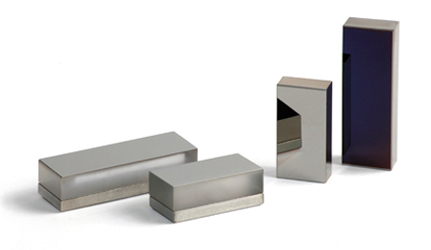Multilayer X-ray Optics
Since more than four decades, multilayer thin films are used as synthetic analyzer crystals in XRF instruments, especially for the detection of light elements by X-ray fluorescence spectrometry in the softer X-ray regime where suitable natural analyzing crystals with sufficiently large lattice spacings to fulfill Bragg’s equation become rare. In the early 90s, Herbert Göbel introduced the first multilayer mirrors for X-ray diffraction, as the progress of thin-film deposition techniques allowed for the fabrication of multilayers with lateral d-spacing variations of the high precision needed to significantly improve the overall reflectivity of these mirrors.
With the increasing importance of X-ray analytical methods, such as small angle scattering (SAXS) and singly crystal diffraction (SC-XRD), Montel multilayer mirrors became more and more important for these applications, especially in structural biology.
A Montel optics is shaping the beam in two dimensions, either as a parallel beam for SAXS applications or as a focused beam for crystallography, while monochromatizing the beam at the same time, typically suppressing the Kβ lines of the anode material and the bremsstrahlung (Δ/E ~2 - 5%). Those Montel optics were first combined with rotating anode generators, and later with the latest generation of microfocus sealed tubes, such as our Incoatec Microfocus Source IµS, significantly increasing the intensity of the source.
As the fabrication techniques for high quality substrates and smooth multilayer thin films have greatly evolved over the past years, synthetic multilayer mirrors are nowadays one of the key components of almost every X-ray analytical instrument due to their excellent beam-shaping properties making them the ideal optics for conserving the source brilliance.
XRF Analyzer Crystals - Optics for X-ray Fluorescence Spectrometry

Incoatec produces optics for X-ray fluorescence devices. As analyzer crystals, they filter the wavelength of interest from the fluorescence radiation emitted by the sample. In addition to our standard products, we also develop custom-made mirrors for specific applications.
The benefits of our XRF mirrors are:
- Mirrors for XRF, TXRF and EPMA
- Energy range: 0.1 - 2.3 keV
- Lower limits of detection for light elements
- Analysis of beryllium, boron and carbon with a 30 % improvement at a quicker rate
- Special custom-made mirrors
As analyzer crystals they select the required wavelength of the fluorescence radiation emitted by the sample. In addition to our standard products we also develop special mirrors for specific applications.
Göbel mirrors - optics for 1D X-ray diffractometry

Incoatec offers various types of optics for X-ray diffraction (XRD) devices. Nowadays the most widespread optics for XRD are the so-called "Göbel Mirrors". The Göbel Mirror (GM) converts the X-ray beam coming from an X-ray tube into a one-dimensionally parallel or focused beam and additionally monochromatizes it. The mirror consists of multilayers with laterally graded thickness, deposited with extreme accuracy onto a prefigured surface.
Montel optics - 2D multilayer mirrors for X-ray diffractometry

In the fifties, M. Montel first introduced an optical scheme for 2D X-ray focusing or collimating optics with two mirrors mounted side by side and mutually perpendicular to each other. Incoatec’s Montel optics consists of two optical surfaces that are coated with laterally graded multilayers. The mirrors either have an elliptical shape for 2D focusing or a parabolic shape for 2D collimating. In a hybrid Montel optics an elliptical and a parabolic mirror are combined in the Montel scheme resulting in a rectangular beam shape.
The advantages of our Montel optics are:
- High brightness
- Symmetrical beam properties (size, divergence) in 2D
- Very clean spectrum due to twofold monochromatization (double-bounce optics)
- Easy to align
For X-ray sources with a very high brightness, such as the MetalJet or the IµS DIAMOND II, technical innovation in the design of the X-ray optics was required, since a smaller source size requires synchrotron-class optics with greater precision in the d-spacing of the multilayers. These superb Montel mirrors deliver a uniform beam with an outstanding intensity, greatly exceeding the intensity of traditional X-ray sources.
